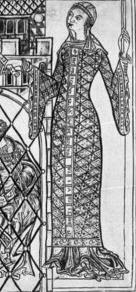Neuper #29

Warp: Purple silk Weft: Purple silk Brocade: White silk Pattern: Anna Neuper #29 Cards: 29 Width: 1.7cm Length: Approx. 1.2 metres What's new: Tiedowns under 1 thread I just got a copy of Anna Neuper's Modelbuch (as published by Nancy Spies and Ute Bargmann). This is a book of brocaded tablet weaving patterns as recorded by Anna Neuper, a nun from Nuremberg, in 1517, at the time when tablet weaving was dying out in favour of other decorative fibre techqiques such as lacemaking. The patterns are all pretty obvious and geometrical. They're all pretty similar to the pattern I used on my garters back in my first brocaded tablet weaving experiment. I was going to start the Mammen bands next but it's taking a while to get the silk. So I thought I'd make one of the patterns from this book. I don't have an immediate use for it so I may donate it as a prize for the Fighter Auction Tourney at Crescent Fence in August. For this band I am using a double thickness of


